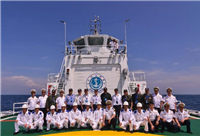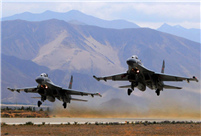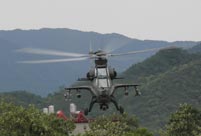

 |
| A televison program shows Director General of the Malaysian Department of Civil Aviation Azharuddin Abdul Rahman announcing a statement, in Kuala Lumpur, Malaysia, on Jan. 29, 2015. Azharuddin Abdul Rahman said on Thursday that the Malaysian government officially declared MH370 an accident, and all 239 people on board the plane were presumed dead. (Xinhua/Chong Voon Chung) |
LOS ANGELES, March 7 -- In an event of a test model plane crash, an emergency recorder and tracking system is separated from the tail section of the plane.
The test, which is shown in a video clip, is part of a series of tests completed since October by the U.S. subsidiary of the Commercial Aircraft Corporation of China (COMAC) on a comprehensive emergency information recorder and tracking system.
COMAC America Corporation says its emergency recorder system includes a data storage and transmitter called Harbinger, claiming for the system it had been applying new methods that transcend traditional designs of black box recorders used in commercial aircraft.
The yearlong searching effort for Malaysia Airlines' missing flight MH370 has turned up with no sign of the plane, but it has fueled the company's resolve to come up with a system more efficient instead.
The flight MH370, a Boeing 777-200, disappeared en route from Kuala Lumpur to Beijing on March 8, 2014, with 239 passengers and crew on board. So far no trace has been found despite a massive surface and underwater hunt, in what has become one of the biggest mysteries in the aviation history.
The search is jointly carried out by Australia, Malaysia and China in the vast swaths of the Indian Ocean some 1,600 kilometers off Australia's west coast, with four ships using sophisticated sonar systems to scour a huge underwater area.
The protracted search for the missing plane's black boxes, or the flight data and cockpit voice recorders, are presenting new demands for aviation security and rescue. Major aircraft makers of the world continue to contribute to black box technologies.
A traditional black box emits distress signals for 30 days after sinking with the plane. It stores 30-minutes of cockpit voice conversation and two hours of flight data before the crash.
However, when the plane crashes and goes down at sea, the sonar signal emitted from the black box only transmits several kilometers, therefore requiring a rather definitive search area, which is often difficult in sea crashes.
If the black box becomes covered in seabed sludge (or heavy snow, in the case of a mountainside crash), distress signals are weak and hard to detect, making it difficult to locate the crash site in a timely manner for rescue.
COMAC America believes that the Harbinger emergency system is a useful supplement to existing black box designs that sink with the plane after a crash.
Engineers of the company say, the Harbinger emergency system is able to capture images of the last few minutes of the plane before it crashes. With the system, the last few minutes of the plane's position, black box data, and video footage is captured through cloud technology to a satellite.
The system can also save a copy of the data and is equipped with a parachute and inflation system to enable it to stay afloat at sea. The inflation system can also protect hardware when the Harbinger lands on hard surfaces. It will also transmit distress signals to help rescue teams locate its position.
Based on repeated tests of the system, the video footage of the last few minutes of a plane crash, for instance, offers invaluable insight into the data captured in a traditional black box. The position tracking system and cloud data transmission function also increases the probability of rapid location of the crash site and the survivability of the captured flight data.
"Being able to find the true cause of an air disaster is a crucial step towards improving aircraft designs for safer air travel tomorrow," said Wei Ye, president of COMAC America Corporation told Xinhua. "The Harbinger emergency system will bring revolutionary changes to air rescue and aviation security."
The company has filed a patent application of the Harbinger emergency system with the U.S. Patent and Trademark Office, said Ye, adding that "we believe new models of commercial aircraft in the future will benefit from using this system."
 China hosts overseas disaster relief exercise for the first time
China hosts overseas disaster relief exercise for the first time 20 pairs of twins who will become flight attendants in Sichuan
20 pairs of twins who will become flight attendants in Sichuan J-11 fighters in air exercise
J-11 fighters in air exercise PLA soldiers operating vehicle-mounted guns in drill
PLA soldiers operating vehicle-mounted guns in drill Beauties dancing on the rings
Beauties dancing on the rings Blind carpenter in E China's Jiangxi
Blind carpenter in E China's Jiangxi Top 10 highest-paid sports teams in the world
Top 10 highest-paid sports teams in the world In photos: China's WZ-10 armed helicopters
In photos: China's WZ-10 armed helicopters UFO spotted in several places in China
UFO spotted in several places in China Obama is sowing discontent in S.China Sea
Obama is sowing discontent in S.China Sea Rescuers work through night to reach cruise ship survivors
Rescuers work through night to reach cruise ship survivors Driving through limbo
Driving through limbo Facing down MERS
Facing down MERSDay|Week